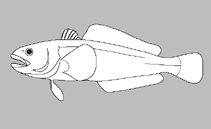Notothenia neglecta Nybelin, 1951
Yellowbelly rockcod
Add your observation in Fish Watcher
| Native range | All suitable habitat | Point map | Year 2050 |

|
| This map was computer-generated and has not yet been reviewed. |
| Notothenia neglecta AquaMaps Data sources: GBIF OBIS |
Upload your photos and videos
Pictures | Google imageNo image available for this species;
drawing shows typical species in Nototheniidae.
Pictures | Google imageNo image available for this species;
drawing shows typical species in Nototheniidae.
Common names from other countries
Classification / Names Nombres comunes | Sinónimos | Catalog of Fishes(Género, Especie) | ITIS | CoL | WoRMS | Cloffa
> Perciformes/Notothenioidei (Icefishes) > Nototheniidae (Cod icefishes) > Nototheniinae
Etymology: Notothenia: Greek, 'notos', ou; νοτος, ου), from the south + Greek, 'e 'eutheneia',as or 'euthenia', as (ευθενεια, ας; ευθενια, ας), abundance (P. Romero, pers.comm. 01/16); neglecta: Named after Dr. Nybelin's feeling that this divergent form of coriiceps has been overlooked (Ref. 11892).
Etymology: Notothenia: Greek, 'notos', ou; νοτος, ου), from the south + Greek, 'e 'eutheneia',as or 'euthenia', as (ευθενεια, ας; ευθενια, ας), abundance (P. Romero, pers.comm. 01/16); neglecta: Named after Dr. Nybelin's feeling that this divergent form of coriiceps has been overlooked (Ref. 11892).
Environment: milieu / climate zone / depth range / distribution range Ecología
marino bentopelágico; rango de profundidad 1 - 95 m (Ref. 11892), usually 1 - 90 m (Ref. 11892). Polar
Distribución Países | Áreas FAO | Ecosistemas | Ocurrencias, apariciones | Point map | Introducciones | Faunafri
Southern Ocean: coast of the Antarctic continent, Antarctic Peninsula, South Georgia, South Shetland, South Orkney Islands and Peter I Island.
Length at first maturity / Tamaño / Peso / Age
Short description Claves de identificación | Morfología | Morfometría
Espinas dorsales (total) : 3 - 7; Radios blandos dorsales (total) : 37 - 40; Espinas anales: 0; Radios blandos anales: 27 - 32. Caudal fin subtruncate or slightly rounded, emarginate in young. Coloration more spectacular compared to other nototheniids. Juveniles with a black blotch on distal end of pectoral fin.
Juveniles found in 1-10 m depth and possibly having a pelagic habit, adults in deeper water (Ref. 11892). Adults feed on crustaceans and fishes (Ref. 11892). Spawn once a year (Ref. 57661). Some information needs to be transferred from N. coriiceps to this species (RF).
Life cycle and mating behavior Madurez | Reproducción | Puesta | Huevos | Fecundidad | Larva
Mature females may spawn for the first time from around 6-8 years of age (Ref. 71843).
Main reference
Upload your references | Referencias | Coordinador | Colaboradores
Miller, R.G., 1993. A history and atlas of the fishes of the Antarctic Ocean. Foresta Institute, Nevada. 792 p. (Ref. 11892)
Threat to humans
Harmless
Human uses
Pesquerías: pesquerías de subsistencia
FAO(pesquerías: producción; publication : search) | FishSource | Sea Around Us
Más información
Trophic ecology
componentes alimenticios
Composición de la dieta
consumo de alimento
Food rations
Despredadores
componentes alimenticios
Composición de la dieta
consumo de alimento
Food rations
Despredadores
Population dynamics
Coeficiente del crecimiento para
Max. ages / sizes
Length-weight rel.
Length-length rel.
Length-frequencies
Mass conversion
Reclutamiento
Abundancia
Coeficiente del crecimiento para
Max. ages / sizes
Length-weight rel.
Length-length rel.
Length-frequencies
Mass conversion
Reclutamiento
Abundancia
Life cycle
Reproducción
Madurez
Fecundidad
Puesta
Spawning aggregations
Huevos
Egg development
Larva
Dinámica larvaria
Reproducción
Madurez
Fecundidad
Puesta
Spawning aggregations
Huevos
Egg development
Larva
Dinámica larvaria
Anatomy
Superficie branquial
Brain
Otolith
Superficie branquial
Brain
Otolith
Physiology
Body composition
Nutrients
Consumo del oxígeno
Tipo de natación
Velocidad de natación
Visual pigments
Fish sound
Diseases & Parasites
Toxicity (LC50s)
Body composition
Nutrients
Consumo del oxígeno
Tipo de natación
Velocidad de natación
Visual pigments
Fish sound
Diseases & Parasites
Toxicity (LC50s)
Genetics
Genética
Heterozygosity
heritabilidad
Genética
Heterozygosity
heritabilidad
Human related
Aquaculture systems
Perfiles de acuicultura
Razas
Ciguatera cases
Stamps, coins, misc.
Aquaculture systems
Perfiles de acuicultura
Razas
Ciguatera cases
Stamps, coins, misc.
Herramientas
E-book | Guía de campo | Claves de identificación | Asistente para frecuencias de tallas | Herramienta de ciclo de vida | Mapa de puntos | Classification Tree
| Catch-MSY |
Special reports
Download XML
Fuentes de Internet
Aquatic Commons | BHL | Cloffa | Websites from users | Check FishWatcher | CISTI | Catalog of Fishes(Género, Especie) | DiscoverLife | ECOTOX | Faunafri | Fishtrace | GenBank(genome, nucleotide) | GloBI | GOBASE | | Google Books | Google Scholar | Google | IGFA World Record | MitoFish | Otolith Atlas of Taiwan Fishes | PubMed | Reef Life Survey | Scirus | SeaLifeBase | Árbol de la vida | Wikipedia(Go, búsqueda) | World Records Freshwater Fishing | Zoobank | Expediente Zoológico
Estimates based on models
Preferred temperature (Ref. 115969): -1.9 - -1.2, mean -1.7 (based on 342 cells).
Phylogenetic diversity index (Ref. 82804): PD50 = 0.5078 [Uniqueness, from 0.5 = low to 2.0 = high].
Bayesian length-weight: a=0.00794 (0.00444 - 0.01422), b=3.24 (3.08 - 3.40), in cm Total Length, based on LWR estimates for this species & (Sub)family-body (Ref. 93245).
Nivel trófico (Ref. 69278): 3.3 ±0.2 se; based on diet studies.
Resiliencia (Ref. 120179): Bajo, población duplicada en un tiempo mínimo de 4.5-14 años (tm=7-8; Fec > 10,000).
Fishing Vulnerability (Ref. 59153): Moderate vulnerability (42 of 100).




